The portable power station market is teaming with high-quality options around every corner. When comparing the EcoFlow Delta Pro Ultra vs. Bluetti EP500, it’s easy to feel overwhelmed by all the numbers, marketing claims, and other details.
We’re here to help. No matter your needs, we’ll strip away the fluff and help you see the true performance of these power stations. After this, you’ll be able to confidently understand what these can power and for how long. Then you can make the choice that fits your situation the best.
Let’s see if the EcoFlow Delta Pro Ultra is better than the Bluetti EP500 and its beefier sibling, the Bluetti EP500Pro.
We carefully select the products and services we link to. If you buy through our links, we may earn a commission. There’s no extra cost to you and it helps us provide this information.
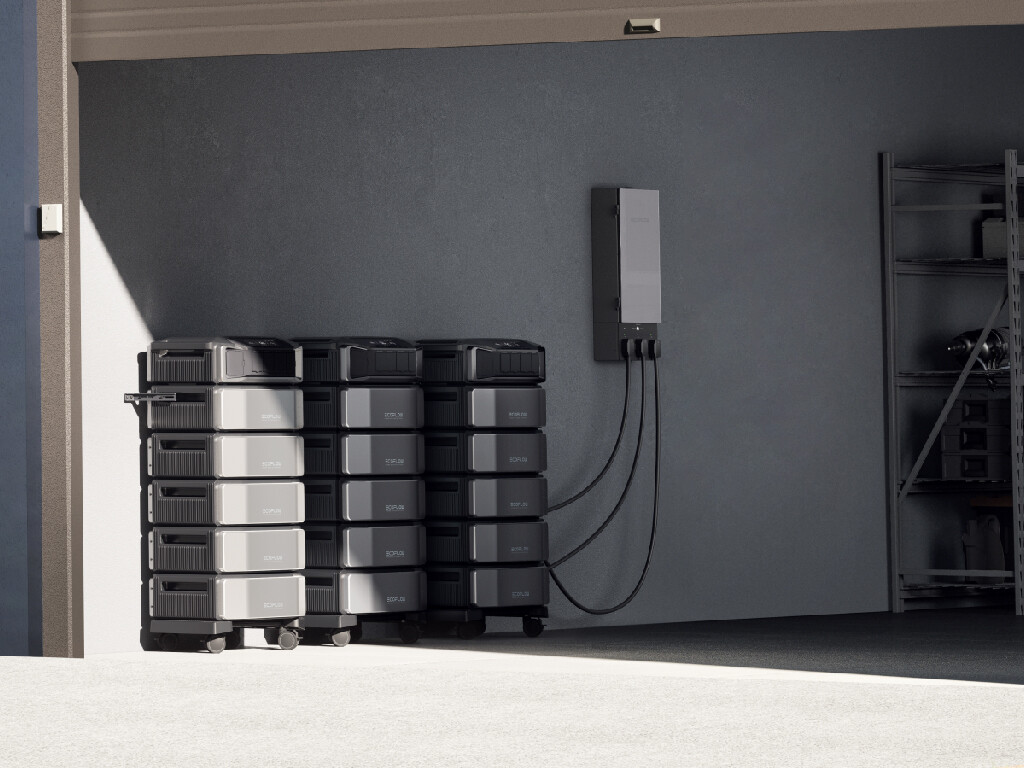
Quick Summary: Massive Modular Against Simple Single-Unit
EcoFlow and Bluetti know what it takes to create the best portable power stations. The EcoFlow Delta Pro Ultra and Bluetti EP500 are two of the most powerful options, ready to handle heavy-duty power needs like a champ.
While there are many excellent features on both options, the EcoFlow Delta Pro Ultra steals the spotlight with its sheer versatility and future-proof design, boasting:
- More than double the AC output
- Modular expansion that blows the EP500 away
- Ultra-fast charging speeds and 240V output
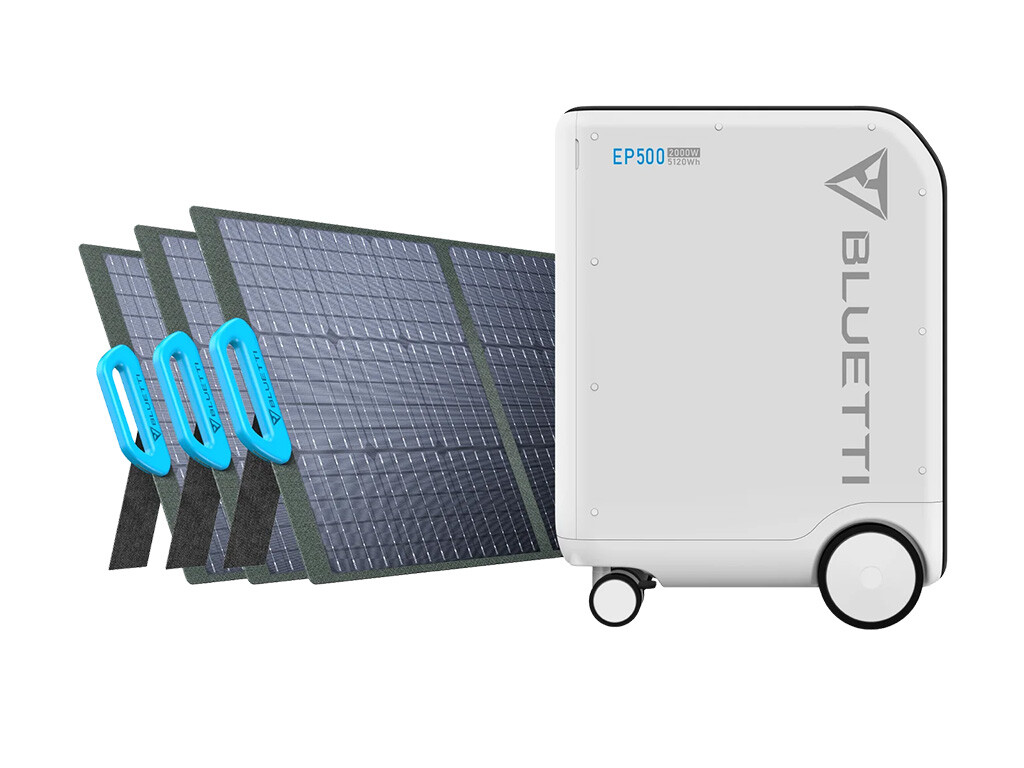
It’s hard to deny the Delta Pro Ultra is better than the EP500. But the EP500 is still worth considering. It’s a lower priced unit that still includes a lot of power, and can be a great solution for some situations. Some of the things we like about the Bluetti EP500 include:
- Impressive battery capacity and capable inverter
- Excellent output options, including high-amp AC and DC
- Online UPS capabilities for seamless backup
We’re going to include details for the Bluetti EP500 and the EP500Pro in this article. The Pro model is superior because it offers a 3kW inverter instead of 2kW, has faster charging rates, and includes a high-amp AC output. This is the list of differences between the Bluetti EP500 and EP500Pro.
Comparing the prices of the Delta Pro Ultra (DPU) to the EP500 and you’ll see that the DPU is more expensive. That extra cost comes with some very serious upgrades to capabilities and features, so it’s well worth it. If you look at the per Wh price of the DPU compared to the EP500Pro, you’ll find they’re very similar with about $1.00 per Wh at full MSRP, but both are often sold for closer to $0.85 per Wh. This is a very competitive price for large power stations and both offer excellent values overall.
The Bluetti EP500 (non-Pro model) has a significantly lower price than both other models. And hits lower per Wh as well, around $0.75 per Wh or less. However, it has a much less capable 2kW inverter, very slow charging rates, and lacks a high-amp AC output, essential for home backup and RV power. We have a hard time recommending the EP500 (non-Pro) unit unless you truly understand its limits. It’s basically a large battery with low-powered outlets and one high-amp DC output.
Did you know you can probably score a 30% solar tax credit for the purchase of these power stations, solar panels, and related accessories?
Deciding between the EcoFlow Delta Pro Ultra and Bluetti EP500Pro is not easy. But for most needs, the EcoFlow Delta Pro Ultra is the better bet. Not only does it come with more capable single-unit features, it can grow with your needs through significant modular expansion. The Bluetti EP500Pro is a top-tier unit that can be great if you don’t need the modular expansion or extra AC power from the Delta Pro Ultra. The EP500 (non-Pro) is only suitable if you want big battery power and don’t mind limited AC output and charging speeds.
Get 5% off most EcoFlow orders with SOLARWAY5OFF discount code.

|
EcoFlow DELTA Pro Ultra |
DPU on EcoFlow DPU on Amazon |
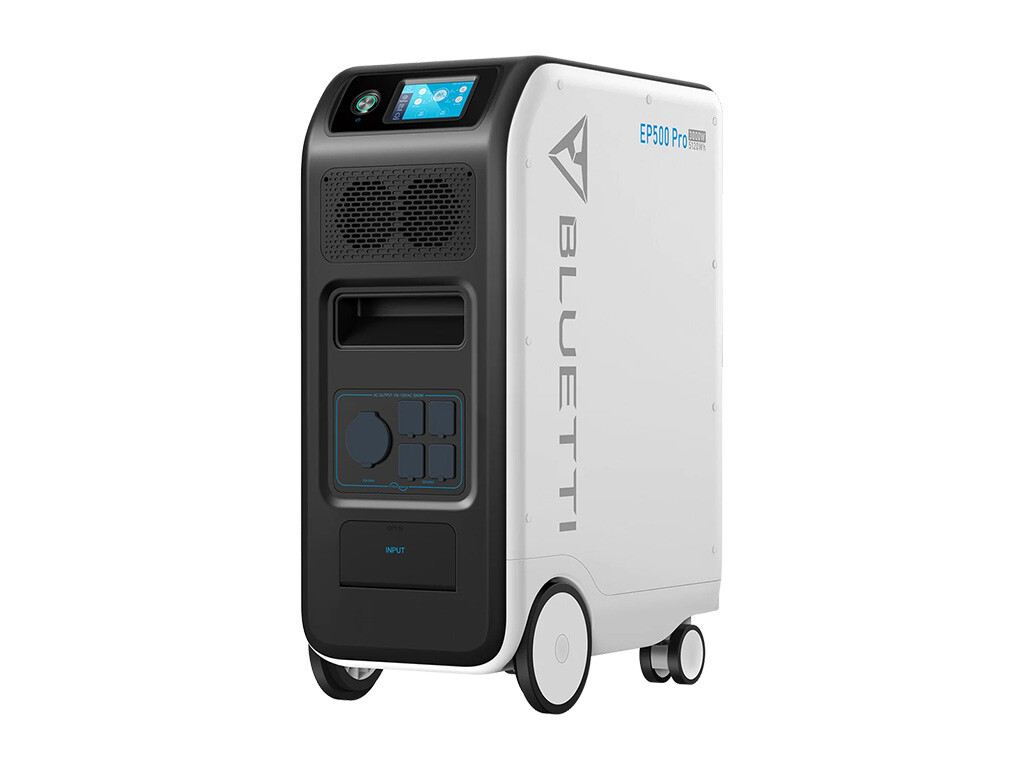
|
BLUETTI EP500Pro |
EP500Pro on Bluetti EP500Pro on Amazon |

|
BLUETTI EP500 |
EP500 on Bluetti EP500 on Amazon |
Head-to-Head Comparison: EcoFlow Delta Pro Ultra vs. Bluetti EP500Pro
We’ve shown you the quick overview. Now it’s time to uncover the details of the capabilities and differences between the Delta Pro Ultra and EP500. These sections not only cover the specs in detail, but they also provide the knowledge you need to actually understand what they can do.
Here’s how we’ll cover this power station comparison:
- What Can These Power? Inverter and Outputs
- How Long Will They Last? Battery Details
- How Fast Do They Recharge? Charging Inputs
- Are They Easy to Move? Portability and Weight
- Which Is Better? Final Verdict
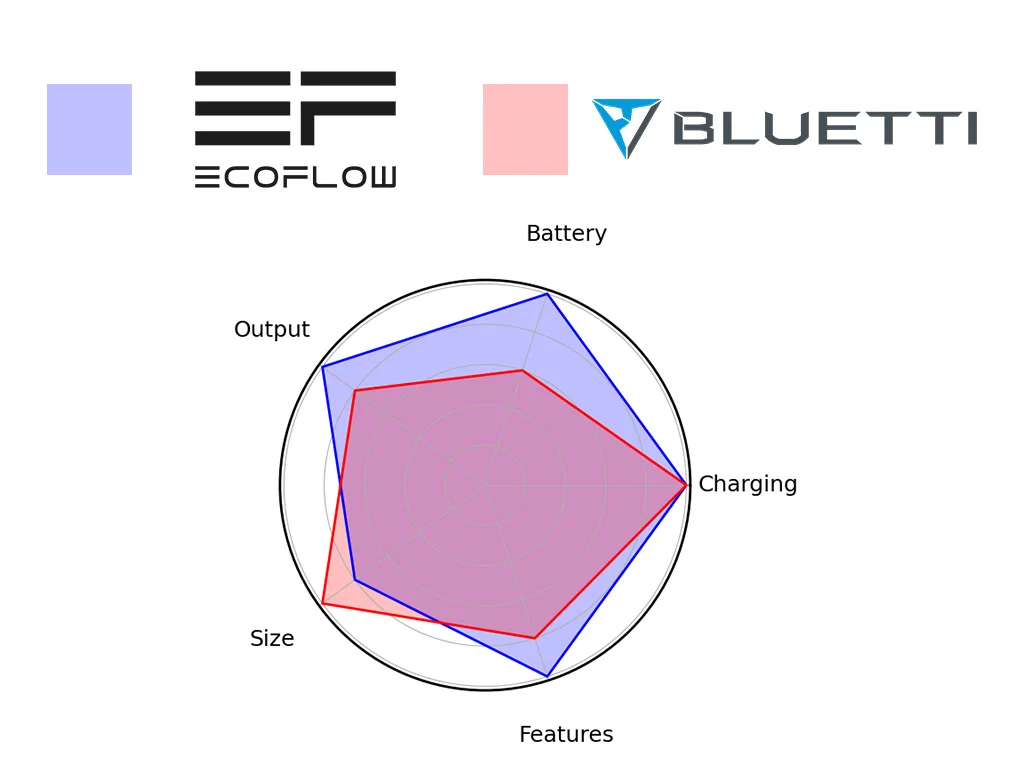
What Can These Power? Inverter Muscle and Outlet Options
When you’re looking at portable power stations like the EcoFlow Delta Pro Ultra and Bluetti EP500Pro, one of the most important factors is the inverter. The inverter turns the DC power stored in the battery into the AC power you use to run household devices.
The size of the inverter determines what kind of gadgets you can power. Higher wattage means powering more devices at once and using larger appliances.
The EcoFlow Delta Pro Ultra packs a whopping 7,200W inverter, while the Bluetti EP500Pro brings a solid 3,000W to the table. The EP500 brings that down to 2,000W.
That difference is serious. The DPU can handle a LOT more power-hungry devices, while the EP500 can hit its upper limit with one appliance. The EP500Pro is reasonable but still will mean a lot more limitations when compared to the DPU.
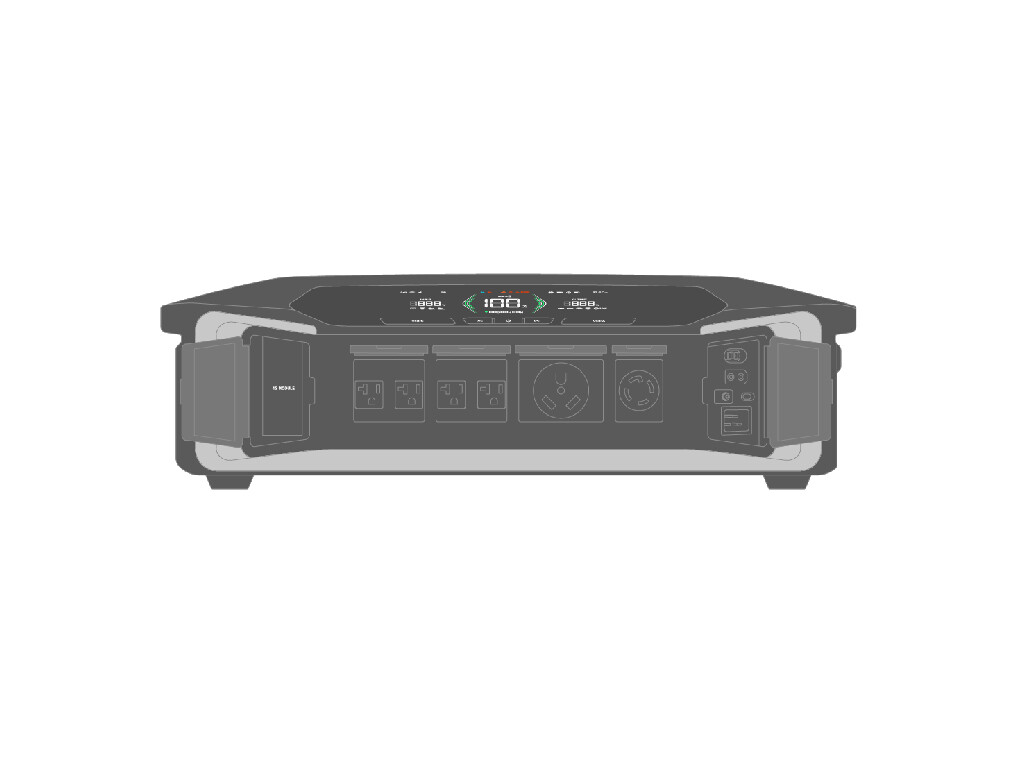
Here’s a look at what common devices run at and how it compares to these inverters:
- Low-watt devices (100W or less):
- Phones, tablets, WiFi routers, laptops, lights, portable fridge
- All power stations can handle these without breaking a sweat.
- Medium-watt devices (200W to 500W):
- Televisions, desktop computers, refrigerators
- The DPU can handle as many of these as you want to throw at it (within reason) while the Bluetti EP500Pro can manage a few at once but can get close to the limit.
- High-watt devices (1,000W to 2,000W):
- Microwaves, power tools, coffee makers, induction cooktops
- The DPU still has plenty of room to power these and other devices, but the EP500Pro will need to be dedicated to powering this one device, unplugging most other devices to do so.
- Heavy-duty appliances (3,000W and up):
- Whole home air conditioners, electric dryers
- This is where the Delta Pro Ultra goes above and beyond. It can handle these heavy-duty needs within reason.
The Delta Pro Ultra and EP500 can both double up inverter power by using more than one unit. Yet the differences are magnified with this expansion. While the EP500Pro doubles to 6kW, the DPU doubles to 14.4kW. And you can actually use three DPUs together for a whopping 21.6kW. The EP500Pro doesn’t touch this absolutely massive inverter output of the DPU.
One feature that’s on all three options is the Uninterruptible Power Supply (UPS) function. It automatically kicks in with battery backup power during a grid blackout. You can keep your computer, server, or medical devices running nonstop with grid and battery power combination.
The EcoFlow and Bluetti options both offer online UPS (0ms) through select outlets and 20ms through others. These are truly remarkable and it’s one reason that going with the lower-cost EP500 can make sense. If you just need a very powerful battery backup with 0ms UPS function, the Bluetti EP500 is one of the best solutions on the market.
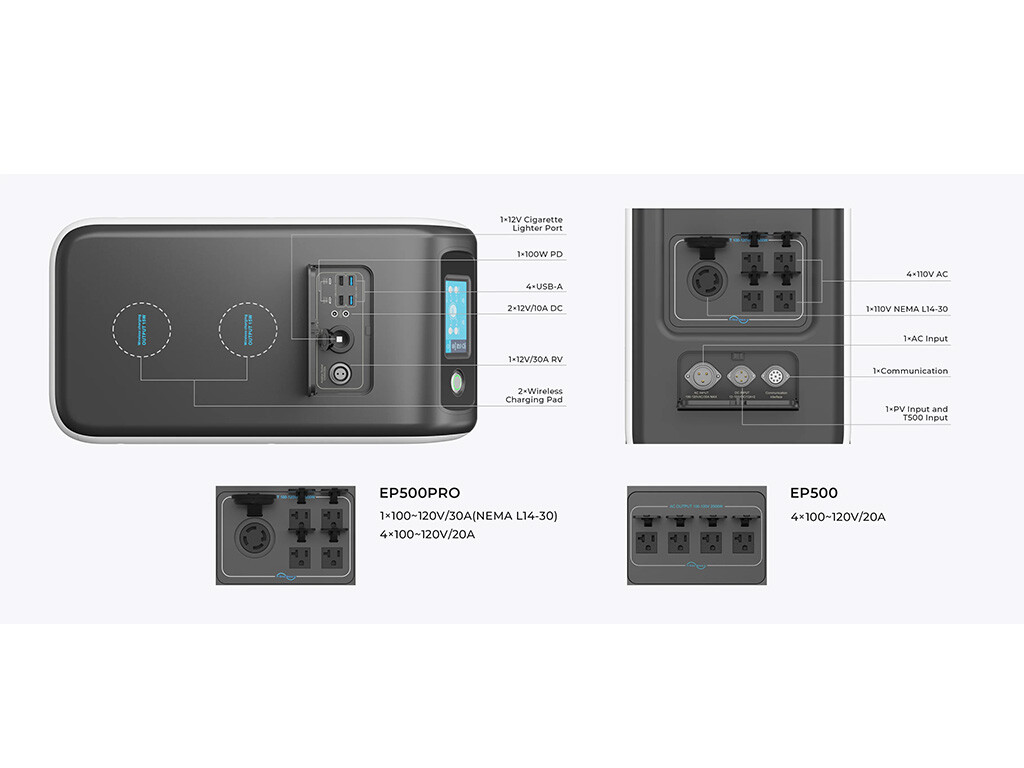
Looking at the total outlets and connections, there’s a lot to like from the Delta Pro Ultra and the EP500Pro. They offer high-amp outputs from the inverter (a 30-amp outlet perfect for RVs and home transfer switches) and high-amp DC output (ideal for powering DC fuse boxes). You’ll also find many USB ports on both.
The DPU goes above the rest by including 240V output, while the EP500 and EP500Pro include a more well-rounded DC output lineup with barrel plugs, cigarette lighter ports, and wireless charging pads. Basically, the DPU is the ultimate high-powered workhorse while the EP500 is better for directly powering smaller devices.
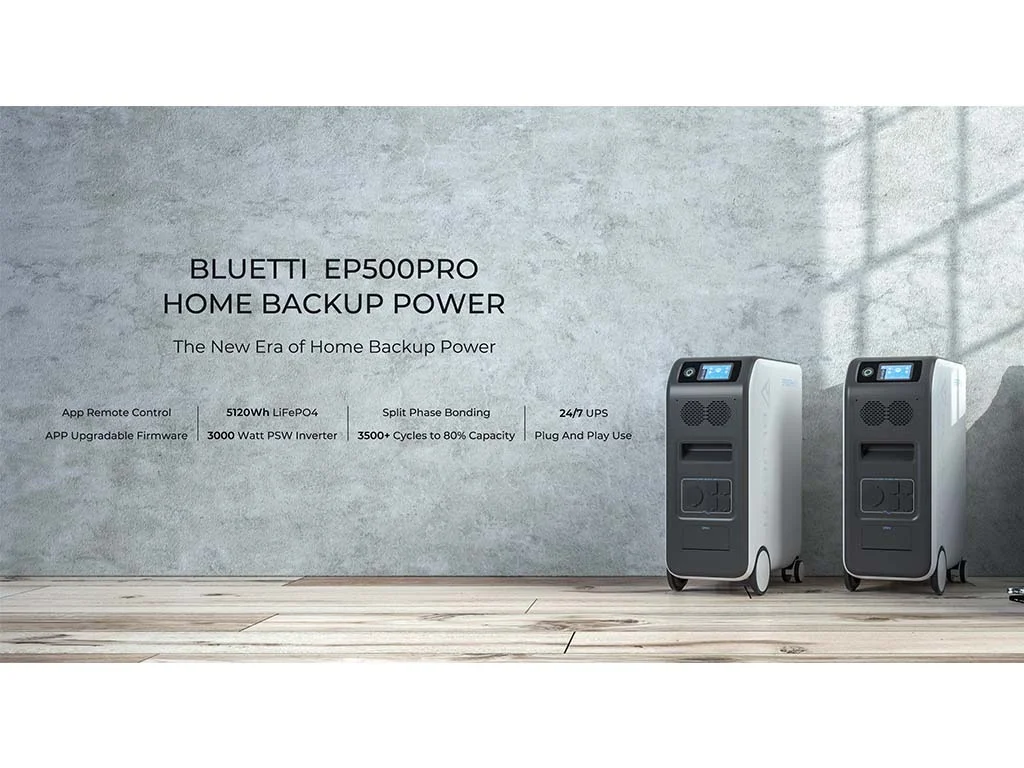
If you want to use these for home backup use, connect them to your home through a transfer switch and critical loads panel. You can use the power stations to run home devices through the existing outlets, including your fridge, lights, and essential electronics. No fumbling with extension cords during an outage.
The Delta Pro Ultra is particularly suited for this, thanks to its higher inverter capacity and flexibility in powering more demanding appliances. The EcoFlow Smart Home Panel 2 is an intelligent automatic transfer switch with next-generation features, including full control and monitoring through the EcoFlow app. You can use the EP500Pro through a traditional transfer switch, but the EP500 is likely too limited due to a lack of high-amp output and its small 2kW inverter.
Output Verdict: The EcoFlow Delta Pro Ultra is far superior with inverter power, offering a massive 7,200W inverter that can handle a wider range of devices, both individually and in combination, with more outlets for flexibility. The Bluetti EP500Pro has a solid 3,000W inverter that’s more than enough for most medium-duty tasks and still includes dual high-amp outputs plus a wider array of DC ports. The EP500 is more limited with a 2kW inverter and no high-amp AC output, although it still has a 30-amp DC output that can be great for campervans and other situations where you want to use a DC fuse box.
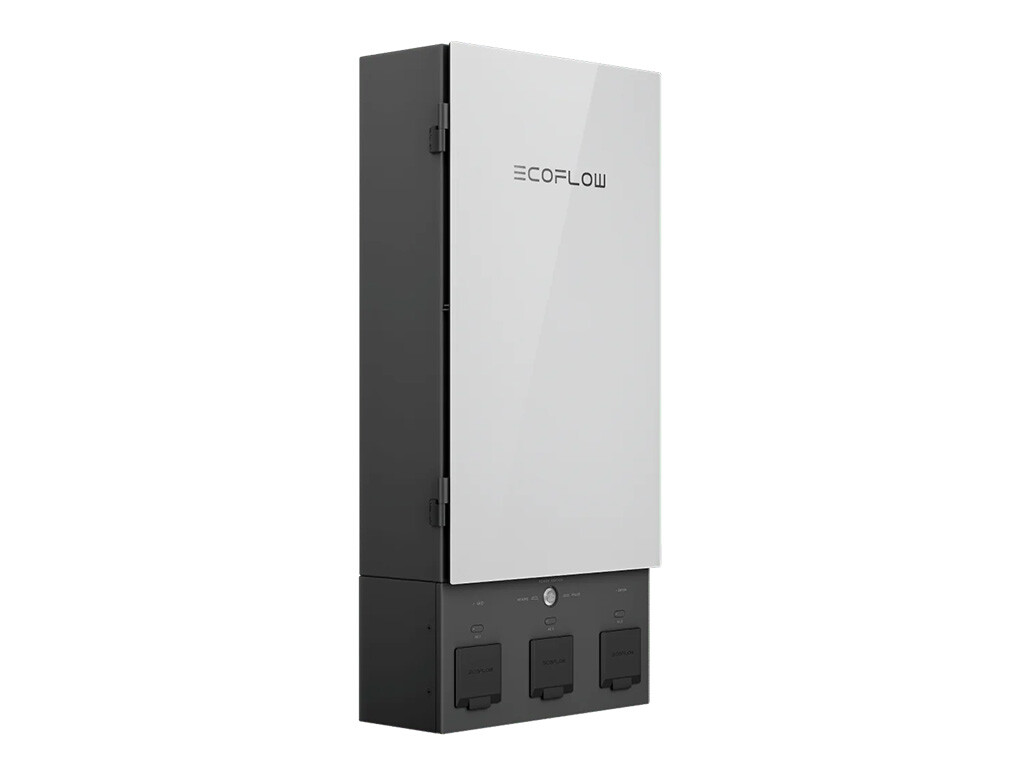
|
EcoFlow Smart Home Panel 2 |
SHP2 on EcoFlow |
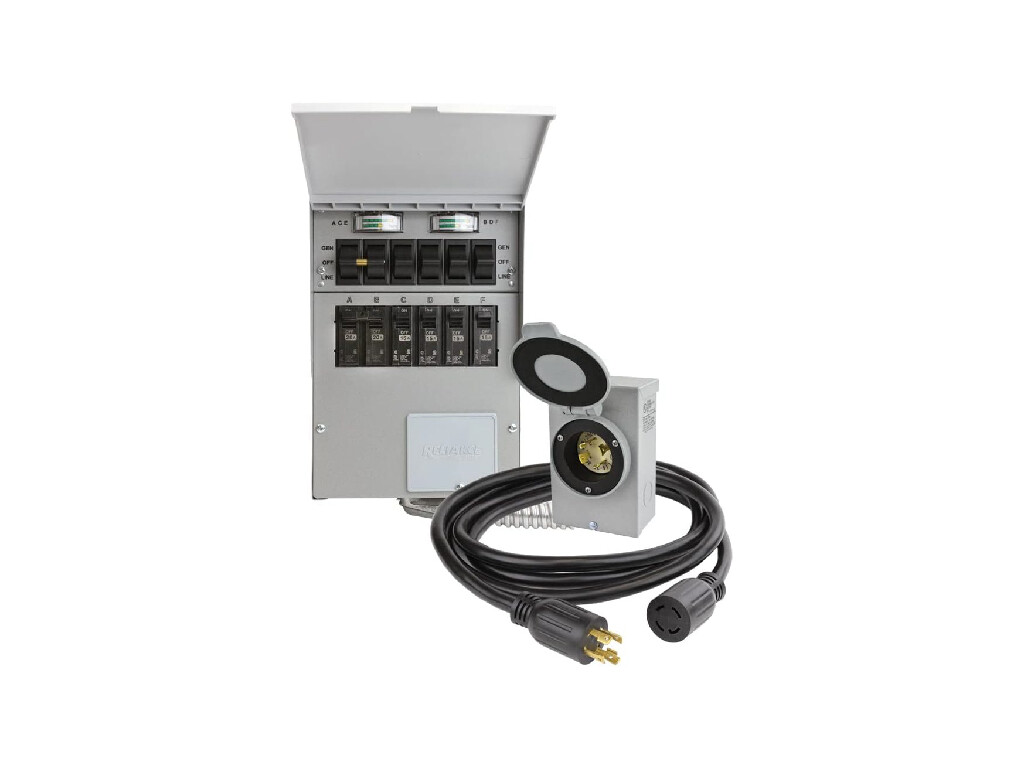
|
Reliance Controls 306CRK Transfer Switch Kit |
Buy on Amazon |
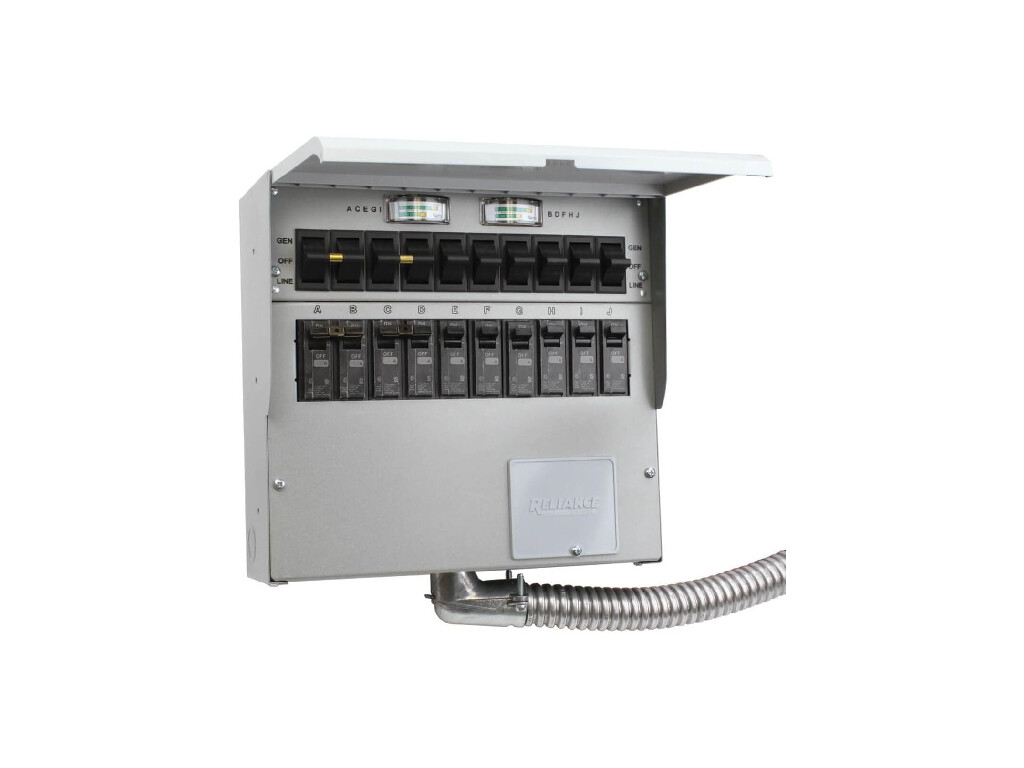
|
Reliance Controls 510C 50-Amp Manual Transfer Switch |
Buy on Amazon |
| Product | EcoFlow DELTA Pro Ultra | BLUETTI EP500Pro | BLUETTI EP500 |
|---|---|---|---|
| AC Output | 7,200W | 3,000W | 2,000W |
| AC Output (System Max) | 21,600W | 6,000W | 4,000W |
| 120V Outlets | 5 (4x20A, 1x30A) | 5 total (4x20A; 1x30A) | 4×16.7A |
| 240V Outlets | 1x30A | – | – |
| UPS / EPS | 0ms / 20ms | 0ms / 20ms | 0ms / 20ms |
| USB-A Ports | 2x15W | 2x15W; 2x36W | 2x15W; 2x18W |
| USB-C Ports | 2x100W | 1x100W; 1x45W | 2x18W |
| Other DC (Anderson or other) | 1x378W (30A) | 30A | 30A |
| DC 5521 (Barrel Plug) | – | 2x120W 10A | 2x120W 10A |
| Cigarette Lighter | – | 1x120W | 1x120W |
| Wireless Charging Pad | – | 2x15W | 2x15W |
| Connectivity | WiFi / Bluetooth / 4G | WiFi / Bluetooth | WiFi / Bluetooth |
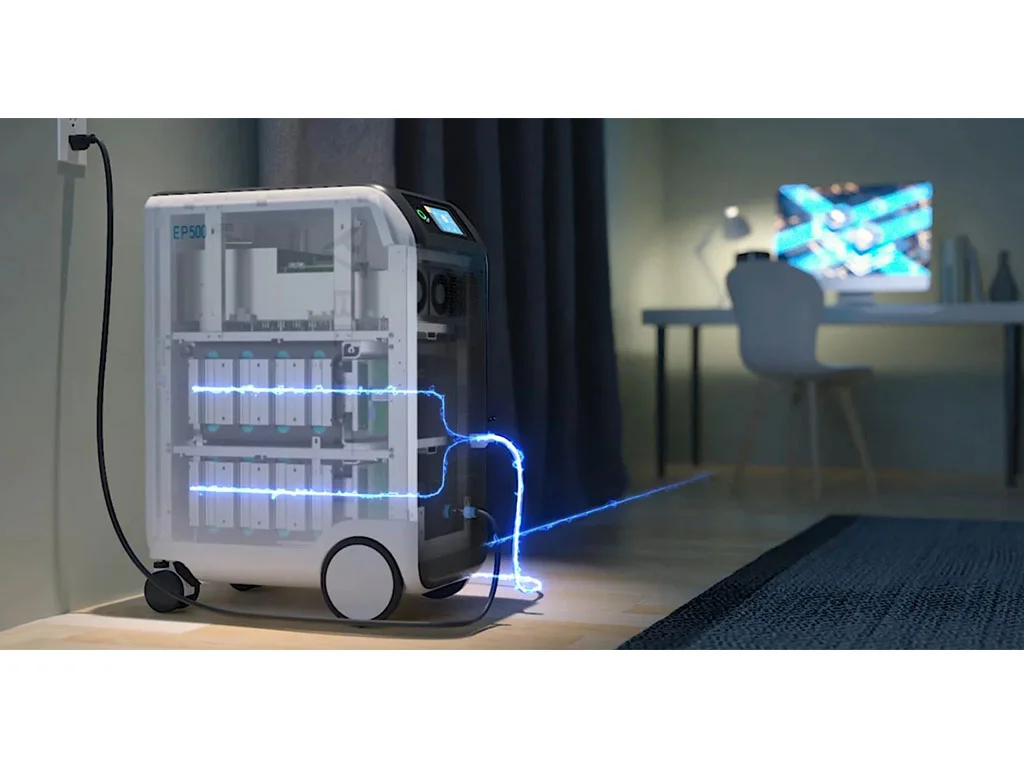
How Long Will They Last? Battery Capacity Breakdown
When comparing the battery capabilities of the EcoFlow Delta Pro Ultra and Bluetti EP500Pro, we’ll see some serious energy storage. Measured in watt-hours (Wh), battery capacity tells you how long the power station can keep your devices running.
The Delta Pro Ultra holds a whopping 6,000Wh, while the EP500Pro clocks in at a solid 5,120Wh. But, of course, that’s not the whole story.
Each Delta Pro Ultra unit can work with five batteries, for 30kWh each. Since you can use three DPU inverter units together, that means the maximum battery capacity is an eye-watering 90kWh. For many homes, that’s enough backup power for more than a week without sacrificing much. It’s almost impossible to beat the massive battery capacity of this heavy-duty EcoFlow power station.
You can use two EP500 units together to reach 10.2kWh. This is still a very large battery to work with, and if you’re certain it meets your needs, there’s no reason to drool over the 90kWh of the EcoFlow.
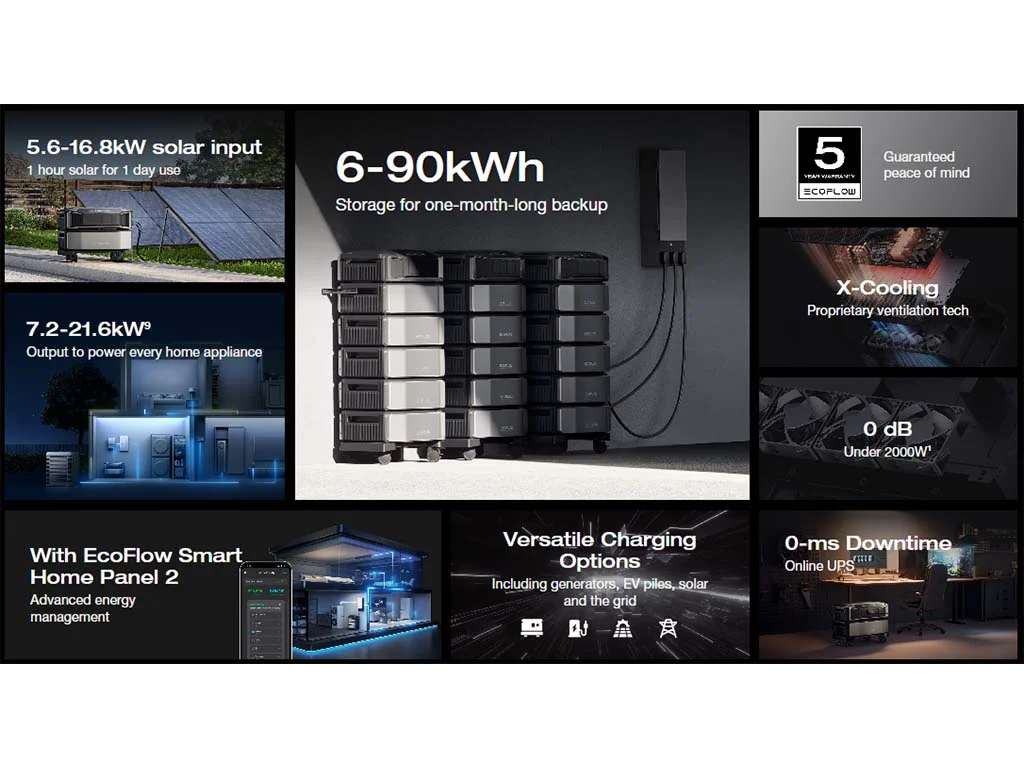
Let’s talk about what these numbers mean in reality.
Running a 60W laptop on the Delta Pro Ultra with a single 6kWh battery would give you roughly 80 hours of use, while the Bluetti EP500Pro offers about 68 hours. This size of device is no problem for either.
If you’re powering something more demanding, like a group of devices that run at a total of 500W (fridge, TV, and some small devices at the same time), the Delta Pro Ultra can keep it running for about 9.5 hours and the EP500Pro for just over 8 hours.
That same 500W load running on the full 90kWh of the maximum DPU system can run for 144 hours (6 days) straight without recharging. The EP500 10.2kWh battery maximum will only last 16 hours.
Both units use LiFePO4 (LFP) batteries. You can expect over 8 years of daily charging and discharging before significant battery capacity degradation. They’re made for longevity and these brands stand behind them. The Delta Pro Ultra and EP500Pro come with solid 5-year warranties, offering peace of mind that these power stations are built to last.
Battery Verdict: The EcoFlow Delta Pro Ultra offers higher base battery capacity and an insane amount of battery expansion. It’s the ideal choice if you want a long-term power solution or a system that can grow as your off-grid power use does. The Bluetti EP500Pro holds its own with 5.1kWh per unit and 10.2kWh total maximum capacity. It’s a strong contender for many household needs, even if it doesn’t withstand comparison to the massive DPU capacity. The EP500 delivers identical battery capacity.
| Product | EcoFlow DELTA Pro Ultra | BLUETTI EP500Pro | BLUETTI EP500 |
|---|---|---|---|
| Battery | 6,000Wh | 5,120Wh | 5,120Wh |
| Battery (System Max) | 90,000Wh | 10,240Wh | 10,240Wh |
| Warranty | 5 years | 5 years | 5 years |
| Battery Type | LiFePO4 / LFP | LiFePO4 / LFP | LiFePO4 / LFP |
| Battery Cycles | >3,000 | >3,000 | >3,000 |
| Buy Now | Buy DPU | Buy EP500Pro | Buy EP500 |
| Buy on Amazon | EcoFlow DPU on Amazon | EP500Pro on Amazon | EP500 on Amazon |
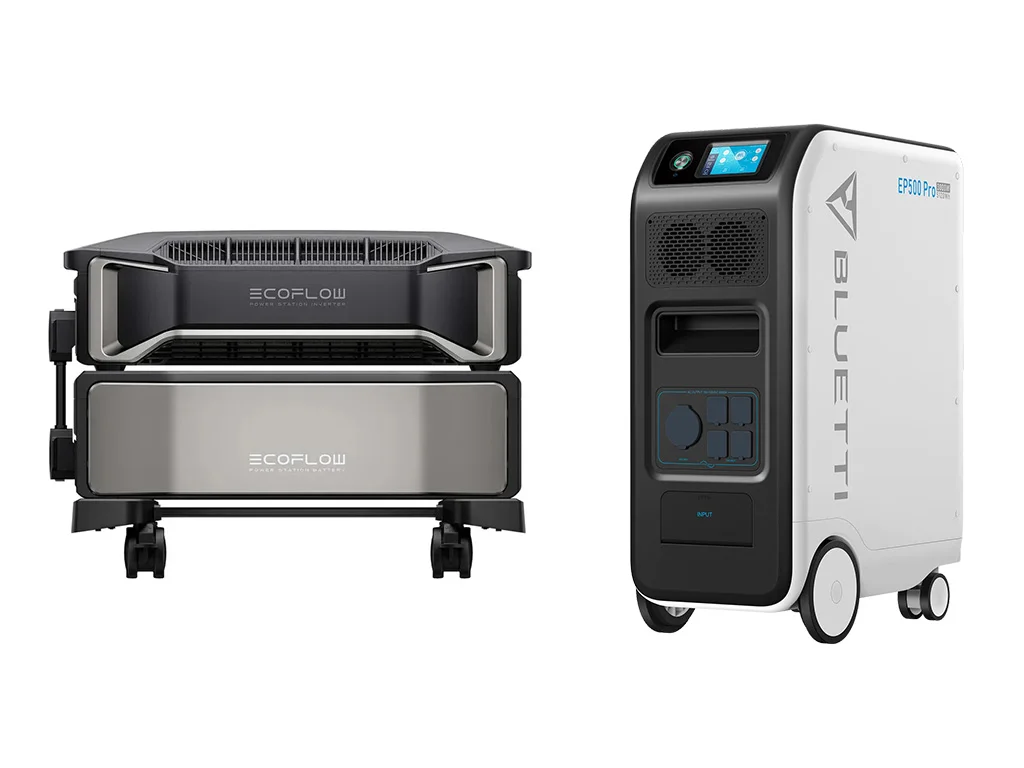
How Fast Do They Recharge? Inputs and Speeds Explained
When it comes to portable power stations, charging speed is critical. Anyone may need to quickly top off their unit before a big adventure or by using off-grid sources like solar panels. A faster recharge means less downtime and more time keeping your devices powered up.
Let’s break down how the EcoFlow Delta Pro Ultra and Bluetti EP500Pro handle the need for speed. Both models offer multiple ways to recharge, but the two most important methods are AC charging and solar power:
- AC Charging: The EcoFlow Delta Pro Ultra crushes the competition with a blistering 7,200W input, recharging fully in about 1 hour if you can find a source to deliver that much power. The Bluetti EP500Pro handles a still-impressive 3,000W, but it takes closer to 2 hours to top off. The EP500 lags far behind with a very slow 600W AC charging rate (>10 hours).
- Solar Charging: The Delta Pro Ultra and EP500Pro have suitable solar charging abilities for their battery sizes. The DPU accepts up to 5,600W of solar through dual inputs, perfect for charging single batteries or a larger modular array. The EP500Pro maxes out at 2,400W of solar through dual inputs, which is very well suited for its 5.1kWh battery. Once again, the EP500 (non-Pro) lags behind with 1,200W total (taking more than 5 hours of peak sunlight to charge).
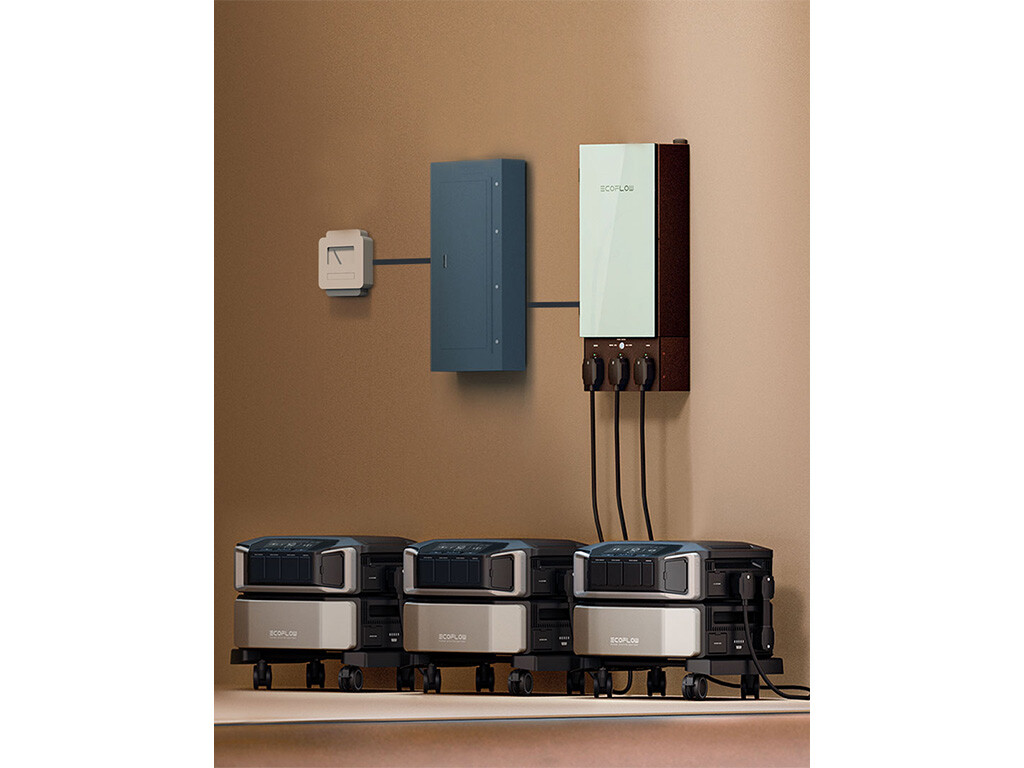
You can use gasoline or propane generators to quickly recharge these power stations as well. The benefit of doing so is a quick boost to the battery, then you can use the silent power for hours without the noisy fuel generator running. You’ll also be able to leverage the powerful inverter which often exceeds fuel generator inverters.
Car charging is tough for power stations of this size. The common car cigarette lighter port only offers 120W, too slow for a significant charge. But you can use other universal car chargers for power stations. The Bluetti 560W Charger 1 and the Pecron 500W DC Car Charger mimic solar output and can actually use your car or RV engine to charge your large power station.
Charging Verdict: Once again, the EcoFlow Delta Pro Ultra dominates with lightning-fast 7,200W AC charging and the ability to pull 5,600W from solar panels. The Bluetti EP500Pro still has very fast charging and a great amount of solar for its battery size, while the EP500 (non-Pro) suffers from charging speeds that are a little too slow and can cause frustration whether using grid AC power or off-grid solar.
| Product | EcoFlow DELTA Pro Ultra | BLUETTI EP500Pro | BLUETTI EP500 |
|---|---|---|---|
| AC Input | 7,200W | 3,000W | 600W |
| AC Recharge Hours (Est.) | 1h | 2h | 10.2h |
| Solar Input | 5,600W | 2,400W | 1,200W |
| Solar Recharge Hours (Est.) | 1.3h | 2.6h | 5.1h |
| Solar Input (System Max) | 16,800W | 4,800W | 2,400W |
| Solar Input 1 Watts | 4000W | 1200W | 1200W |
| Solar Input 1 Volts Min | 80V | 12V | 55V |
| Solar Input 1 Volts Max | 450V | 150V | 145V |
| Solar Input 1 Amps | 15A | 12A | 20A |
| Solar Input 2 Watts | 1600W | 1200W | – |
| Solar Input 2 Volts Min | 30V | 12V | – |
| Solar Input 2 Volts Max | 150V | 150V | – |
| Solar Input 2 Amps | 15A | 12A | – |

Are They Easy to Move? Weight and Dimensions
If you need flexibility on the go, it’s crucial to be aware of the portability of these power stations. While many power stations offer extremely compact systems easy to bring anywhere, things are a little different for these heavy-duty options. You can still move them, but it’s going to be more challenging.
Although the Bluetti EP500Pro weighs 183 lbs (83 kg), it comes with a major advantage. It’s a compact, all-in-one unit that sits on wheels, making it surprisingly easy to maneuver. Whether you’re sliding it into tight corners at home or tucking it away in your RV, its design allows for convenient placement and mobility despite the heft.
On the other hand, the EcoFlow Delta Pro Ultra keeps its weight down by separating the inverter from the battery, with the main unit weighing 70 lbs (31.7 kg). However, once you add the battery (over 100 lbs), the total weight surpasses the EP500Pro. While this modular approach allows for more flexibility in moving components individually, it does come at the cost of convenience when you need the full setup.
Portability Verdict: Despite its higher overall weight, the Bluetti EP500Pro takes the edge in portability thanks to its compact, all-in-one design and wheels, making it much easier to handle and position. While the EcoFlow Delta Pro Ultra offers more flexibility with its modular setup, the separate components mean additional weight and complexity for full power use. For ease of mobility and placement, the EP500Pro wins.
| Product | EcoFlow DELTA Pro Ultra | BLUETTI EP500Pro | BLUETTI EP500 |
|---|---|---|---|
| Weight (lbs) | 70lbs | 183lbs | 167.5lbs |
| Weight (kg) | 31.7kg | 83kg | 76kg |
| Dimensions (in) | 27.2×18.9×8.4in | 22.8×11.8×29.9in | 22.8×11.8×29.9in |
| Dimensions (mm) | 690x481x214mm | 580x300x760mm | 580x300x760mm |

Which Is Better? Our Top Pick
After diving deep into the specs and features of both the EcoFlow Delta Pro Ultra and Bluetti EP500Pro, both power stations have shown they have what it takes to deliver premium systems with big power. The decision is largely dependent on your specific needs.
The EP500 can’t touch the absolutely massive modular expansion potential of the Delta Pro Ultra. It also has a much more powerful inverter, 240V output, and faster solar charging. It’s a future-forward power station that can grow with your needs with nearly limitless potential.
On the other hand, the Bluetti EP500Pro is still a very powerful system with a large battery and impressive high-amp outputs. Its battery is enough for days of home backup power, and it features online UPS, fast solar charging, and a larger array of DC outputs. The EP500 (non-Pro) keeps costs down but cuts out the high-amp AC output and suffers from slow charging rates.
| EcoFlow Delta Pro Ultra | Bluetti EP500Pro |
|---|---|
Here’s a quick recap of the key points:
- Inverter and Outputs: The Delta Pro Ultra takes the lead with its massive 7,200W inverter, handling high-watt devices effortlessly. However, the EP500Pro provides more than enough power for most users and has versatile high-amp AC/DC outputs. The EP500 is more limited and not capable of powering large devices.
- Battery Capacity: The Delta Pro Ultra offers a higher base capacity and far superior expansion options, making it ideal for long-term power. Still, the EP500Pro delivers plenty of juice with its 5,120Wh battery and compact, all-in-one design. The EP500 has the same 5.1kWh battery.
- Charging Speeds: The Delta Pro Ultra wins here with incredibly fast AC and solar charging inputs, making it perfect for users who need to recharge quickly between uses. The EP500Pro is slightly slower but completely acceptable and has fast charging speeds for its battery size. The EP500 has a frustratingly slow AC charging rate and a lackluster solar speed too.
- Portability: The EP500Pro might be heavier, but it’s wheeled and has an integrated battery. The Delta Pro Ultra splits its weight between components, which adds flexibility but makes full portability a bit trickier.
- Value: The EP500 is the lowest total price and lowest per Wh price but has features to match that are much worse than the other models. The EP500Pro is cheaper than the Delta Pro Ultra, but when compared on a price per Wh, that price evens out. This leaves the Delta Pro Ultra as offering the best value because it is stacked with far superior features and will be a better long-term investment due to the available modular growth.
Overall Recommendation: The EcoFlow Delta Pro Ultra is the better power station in this comparison. It delivers maximum power, rapid recharging, and the ability to expand their system over time. It’s the best option for those preparing for long-term off-grid setups or powering an entire home during an outage.
The Bluetti EP500Pro can keep the cost down while still including everything necessary for a reliable home backup or RV power. What it lacks is the serious modular expansion and the super-powered inverter for heavy-duty devices. We have a tough time recommending the EP500 (non-Pro) unless you’re certain the charging speeds and lack of a high-amp AC output won’t pose a problem for your needs. It can be a great online UPS device with a massive battery.
Get 5% off most EcoFlow orders with SOLARWAY5OFF discount code.

|
EcoFlow DELTA Pro Ultra |
DPU on EcoFlow DPU on Amazon |

|
BLUETTI EP500Pro |
EP500Pro on Bluetti EP500Pro on Amazon |

|
BLUETTI EP500 |
EP500 on Bluetti EP500 on Amazon |
Spec Comparison Chart: EcoFlow Delta Pro Ultra vs. Bluetti EP500
Here’s a spec comparison chart for the EcoFlow Delta Pro Ultra, Bluetti EP500Pro, and Bluetti EP500. It’s a quick look at all the important details in one spot, including links to the user manuals for each power station.
| Product | EcoFlow DELTA Pro Ultra | BLUETTI EP500Pro | BLUETTI EP500 |
|---|---|---|---|
| Battery | 6,000Wh | 5,120Wh | 5,120Wh |
| Battery (System Max) | 90,000Wh | 10,240Wh | 10,240Wh |
| AC Output | 7,200W | 3,000W | 2,000W |
| AC Output (System Max) | 21,600W | 6,000W | 4,000W |
| AC Input | 7,200W | 3,000W | 600W |
| AC Recharge Hours (Est.) | 1h | 2h | 10.2h |
| Solar Input | 5,600W | 2,400W | 1,200W |
| Solar Recharge Hours (Est.) | 1.3h | 2.6h | 5.1h |
| Solar Input (System Max) | 16,800W | 4,800W | 2,400W |
| Warranty | 5 years | 5 years | 5 years |
| Weight (lbs) | 70lbs | 183lbs | 167.5lbs |
| Weight (kg) | 31.7kg | 83kg | 76kg |
| Dimensions (in) | 27.2×18.9×8.4in | 22.8×11.8×29.9in | 22.8×11.8×29.9in |
| Dimensions (mm) | 690x481x214mm | 580x300x760mm | 580x300x760mm |
| Solar Input 1 Watts | 4000W | 1200W | 1200W |
| Solar Input 1 Volts Min | 80V | 12V | 55V |
| Solar Input 1 Volts Max | 450V | 150V | 145V |
| Solar Input 1 Amps | 15A | 12A | 20A |
| Solar Input 2 Watts | 1600W | 1200W | – |
| Solar Input 2 Volts Min | 30V | 12V | – |
| Solar Input 2 Volts Max | 150V | 150V | – |
| Solar Input 2 Amps | 15A | 12A | – |
| Battery Type | LiFePO4 / LFP | LiFePO4 / LFP | LiFePO4 / LFP |
| Battery Cycles | >3,000 | >3,000 | >3,000 |
| 120V Outlets | 5 (4x20A, 1x30A) | 5 total (4x20A; 1x30A) | 4×16.7A |
| 240V Outlets | 1x30A | – | – |
| UPS / EPS | 0ms / 20ms | 0ms / 20ms | 0ms / 20ms |
| USB-A Ports | 2x15W | 2x15W; 2x36W | 2x15W; 2x18W |
| USB-C Ports | 2x100W | 1x100W; 1x45W | 2x18W |
| Other DC (Anderson or other) | 1x378W (30A) | 30A | 30A |
| DC 5521 (Barrel Plug) | – | 2x120W 10A | 2x120W 10A |
| Cigarette Lighter | – | 1x120W | 1x120W |
| Wireless Charging Pad | – | 2x15W | 2x15W |
| Connectivity | WiFi / Bluetooth / 4G | WiFi / Bluetooth | WiFi / Bluetooth |
| User Manual | User Manual | User Manual | User Manual |
| Buy Now | Buy DPU | Buy EP500Pro | Buy EP500 |
| Buy on Amazon | EcoFlow DPU on Amazon | EP500Pro on Amazon | EP500 on Amazon |
Get 5% off most EcoFlow orders with SOLARWAY5OFF discount code.

|
EcoFlow DELTA Pro Ultra |
DPU on EcoFlow DPU on Amazon |

|
BLUETTI EP500Pro |
EP500Pro on Bluetti EP500Pro on Amazon |

|
BLUETTI EP500 |
EP500 on Bluetti EP500 on Amazon |
Final Summary
The EcoFlow Delta Pro Ultra stands out with its massive inverter and battery expansion capabilities, making it perfect for users needing maximum power and rapid charging. You have to pay a little more for its superior features, but it’s worth the extra cost. The Bluetti EP500Pro has slightly lower in capacity yet still offers a lot of battery capacity, a capable inverter, and high-amp outputs with fast charging speeds. It can be a way to save some money as long as you know you won’t outgrow it.
If you’re looking for more details, be sure to check out our full reviews of the EcoFlow Delta Pro Ultra and Bluetti Comparison Charts. Also see our other comparison articles:
- EcoFlow Delta Pro Ultra vs. Bluetti EP900
- EcoFlow Delta Pro Ultra vs. Anker F3800
- EcoFlow Delta Pro 3 vs. Bluetti AC500
Don’t leave yourself in the dark. Get the power you need today, whether at home or off-grid, by investing in the right power station for your lifestyle. Discover a new confidence through any situation.







